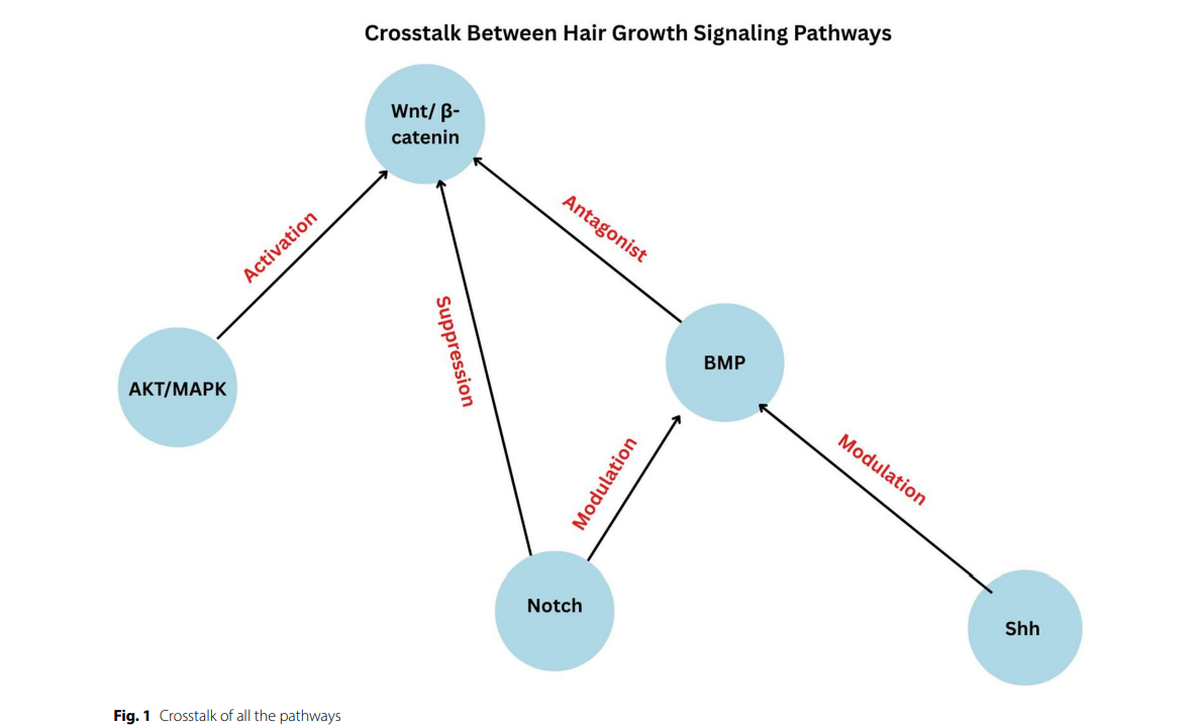A study titled ‘Pathophysiological Mechanisms of Hair Follicle Regeneration and Potential Therapeutic Strategies’ published in Stem Cell Research & Therapy (2025) explains how hair loss, especially androgenetic alopecia (AGA), is caused by problems in the body’s natural hair growth signals — not just hormones or ageing. The review focuses on five important biological pathways — Wnt/β-catenin, Sonic Hedgehog (Shh), BMP, Notch, and AKT/MAPK that help control when hair grows, falls and regrows.

The study highlights five key pathways in our cells that control hair growth, loss, and regrowth. These pathways are like signals that help hair grow or fall out
| Photo Credit:
Special Arrangement
Study highlights
The study found that in people living with AGA, the signals that help hair grow (like Wnt and Shh) are blocked, while signals that stop growth (like BMP and TGF-β) are more active. This leads to smaller, weaker hair follicles that stop producing hair over time. “These signals work together like a team,” Debraj Shome, co-founder and director at The Esthetic Clinics and Depti Bellani, senior manager medical affairs and research at QR678 and lead authors of the study explain. “To fix the problem, we need to focus on all of them — not just one.”
Current treatments like minoxidil (topical solution that works by increasing blood flow to the scalp and extending the hair’s growth phase) and finasteride (oral medication that reduces the production of dihydrotestosterone (DHT), a hormone that contributes to hair follicle miniaturisation and hair loss) can slow down hair loss or help with some regrowth, but they do not treat the real reason why follicles stop working.
The study highlights new types of treatments that are being tested, such as small molecules that can restart growth signals, stem cell therapy and gene editing. Formulations such as QR678, developed by the authors’ research team, are also part of this new approach.
Shift in hair loss treatment
Experts say this could mark a big shift in how hair loss is treated. Instead of just covering up the symptoms, future treatments may be able to restart the hair follicle’s natural growth process. However, the study also warns that activating these signals too much, especially Wnt or AKT — can be risky and must be done carefully.
With over 50% of men and 25% of women affected by AGA by the age of 50, the authors say it’s time to look at hair loss not just as a cosmetic problem, but as a health issue that can be treated by understanding how the body’s regenerative systems work. “This isn’t just about growing hair,” they said. “It’s about waking up the body’s natural repair systems and helping hair follicles work the way they’re meant to.”
The authors also stress the importance of collaboration across medical specialties to move this research forward. Since hair loss is linked to hormonal changes, immune responses, and genetic factors, a combined approach involving dermatologists, endocrinologists, geneticists, and regenerative medicine experts is essential. “Personalised treatment plans based on each person’s biological profile will likely give better results,” the authors note. They add that wider clinical trials, safety studies and shared research efforts will be key to turning these scientific findings into real, effective therapies for patients.

Various forms of hair loss and regenerative medicine
The study also points out that other forms of hair loss, such as scarring alopecia, autoimmune types like alopecia areata and hair loss caused by chemotherapy are linked to similar problems in the body’s regenerative signalling systems. This suggests that the same scientific approach could help treat a wider range of hair loss conditions. The authors say that the hair follicle is more than just a cosmetic structure, it functions like a mini-organ and offers valuable insight into how tissues heal, how the immune system protects certain cells, and how stem cells behave.
By studying hair follicles, researchers can also learn more about the body’s broader ability to repair itself, making hair loss an important area of focus in regenerative medicine.
